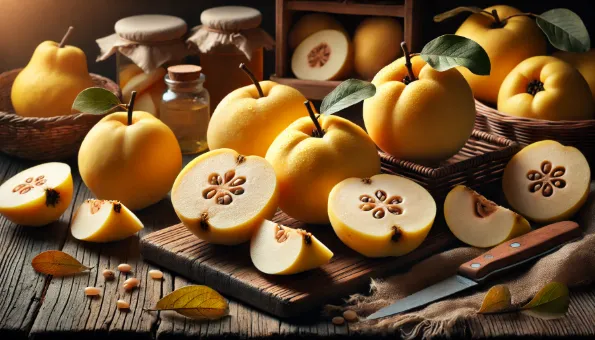Quince: Fragrant Ancient Fruit Rich in Pectin Fiber, Vitamin C & Floral Acidity
Raw quince is hard and astringent, but slow cooking transforms it into rosy, perfumed slices packed with pectin, vitamin C and gentle floral sweetness.

What Is Quince?
Quince (*Cydonia oblonga*) is a **golden, knobbly pomaceous fruit** related to apples and pears. Eaten almost exclusively **cooked**: heat breaks down cell walls, converts tannins, and triggers a pink–ruby hue via polyphenol oxidation.
Nutrition (per 100 g raw)
| | Amount | %DV |
|---|---|---|
| Calories | 57 kcal | — |
| **Carbohydrate** | 15.3 g | 6 % |
| – Fiber (pectin-rich) | 1.9 g | 7 % |
| **Vitamin C** | 15 mg | 17 % |
| Potassium | 197 mg | 4 % |
| Copper | 0.1 mg | 11 % |
Polyphenols (catechins, chlorogenic acid) contribute antioxidant activity.
Potential Benefits
- **Pectin fiber** supports satiety, healthy cholesterol & gel formation in jams.
- **Vitamin C & polyphenols** provide antioxidant protection.
- Gentle **fragrant acidity** lets you reduce added sugar in preserves compared with low-flavor fruits.
- Traditional preparations (poached quince) offer **lower glycemic load** when sweetener is moderated.
Drawbacks & Precautions
- **Inedible raw** for most palates: very hard & astringent—requires cooking (poach, bake, roast, stew).
- High natural acidity means added sugar is often used; balance with spices & citrus to **cut sugar by 15–30%**.
- Browning occurs quickly after cutting; keep pieces in acidulated water (lemon).
Culinary Uses
- **Poach** wedges gently (1:1 water:sugar or lighter syrup) with lemon, vanilla, star anise until rosy.
- Reduce poaching liquid into glaze for yogurt, oatmeal or panna cotta.
- Make **membrillo (quince paste)** to pair with manchego or sharp cheeses.
- Add diced quince to lamb or tagine for sweet-tart depth.
- Incorporate into pies mixed with apples/pears for structure (pectin boosts set).
Preparation & Technique
- Use a **sturdy knife**; peel, quarter, core (tough core).
- Acidulated water prevents enzymatic browning before cooking.
- Long, low **poach (45–90 min at 85–90 °C)** develops color & aroma; rapid boil can toughen.
- For paste: cook purée + sugar (≈ equal weight) to 103–105 °C then dry.
Selecting Quality Fruit
- Choose **firm, heavy fruits** with strong floral perfume.
- Skin: bright yellow with minimal bruising; russet patches are cosmetic.
- Small fuzz rubs off at maturity; avoid shriveled or green fruit (unripe).
Storage
Refrigerate whole quince **up to 4 weeks** (ethylene producers—keep away from leafy greens). Cut fruit: refrigerate airtight, use within 3 days. Poached quince keeps 7–10 days chilled in syrup; paste (membrillo) stores months when wrapped & cool.
Sustainability Notes
Quince is **hardy & pest-resistant**, often needing fewer sprays than apples. Its long storage life lowers waste. Using lighter-sugar preserves reduces refined sugar footprint; cores/peels can be simmered to extract extra pectin for other jams.
Key Takeaways
✔︎ Aromatic, pectin-rich fruit for preserves & cheese boards
✔︎ Source of vitamin C & polyphenols
✖︎ Needs cooking & knife care; manage added sugars thoughtfully.
- 1. Quince

